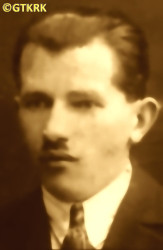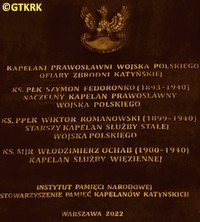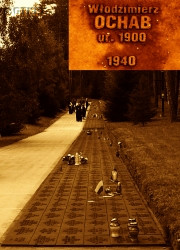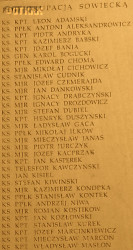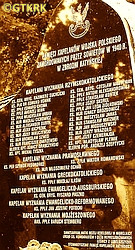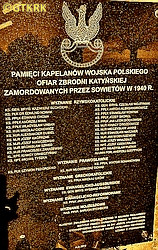Roman Catholic
St Sigismund parish
05-507 Słomczyn
85 Wiślana Str.
Konstancin deanery
Warsaw archdiocese, Poland
full list:
displayClick to display full list

searchClick to search full list by categories
wyświetlKliknij by wyświetlić pełną listę po polsku

szukajKliknij by przeszukać listę wg kategorii po polsku

Martyrology of the clergy — Poland
XX century (1914 – 1989)
personal data
surname
OCHAB
surname
versions/aliases
OCHWAB, OCHWAP
forename(s)
Vladimir (pl. Włodzimierz)
function
presbiter (i.e. iereus)
creed
Eastern Orthodox Church ORmore on
en.wikipedia.org
[access: 2014.09.21]
diocese / province
Warsaw‐Chełm OR eparchy (Polish Autocephalous Orthodox Church PAOC)
OR Military Ordinariate of Polandmore on
pl.wikipedia.org
[access: 2024.12.13]
honorary titles
War Order of Virtuti Militari — Silver (5th Class)more on
War Order of Virtuti Militari – Silver (5th Class)
(11.11.1976, Londontoday: London Cou., England, United Kingdom
more on
en.wikipedia.org
[access: 2024.03.19], decree of Stanislav Ostrowski, President of the Republic of Poland in exile)
September Campaign Crossmore on
September Campaign Cross
(01.01.1986, Londontoday: London Cou., England, United Kingdom
more on
en.wikipedia.org
[access: 2024.03.19], decision of George Premyslav Morawicz, Minister of Military Affairs of the Polish Government in exile)
date and place
of death
04.1940

NKVD TverHQ at 17 4 Sovetskaya Str
today: Tver Medical Institute, Tver oblast, Russia
more on
en.wikipedia.org
[access: 2021.10.09]
alt. dates and places
of death
22.04.1940 (after)
details of death
In 1936 prob. became the chaplain of the Polish Army reserve.
In 1938, during the polonization and restitution action, aimed at „limiting the influence of the Orthodox Church” in southern Podlachia and Chełm region, carried out by the Polish authorities, deprived of his parish in Buśnia (for celebrating — despite the ban — services in Buśno, fined to the amount of 400 Polish zloty).
After German and Russian invasion of Poland in 09.1939 and start of the World War II, after start of Russian occupation, arrested by the Russians on 13.10.1939 in Drohobych.
Jailed in the NKVD filtration camp PFL Shepetivka and next in KLW Ostashkov concentration camp in Ostachkov.
From KLW Ostashkov — his name is on the NKVD deportation list No. 038/2 prepared on 20.04.1940, item 54 (case No. 5985), with an order to be placed at the disposal of the head of the NKVD Directorate in Tver — deported prob. in 04.1940 (the date is unknown, but judging by the date of preparation of the deportation list, deportation took place — as in other known cases — shortly thereafter) to the execution site in Tver and murdered.
By Polish Minister of Defence’s decision No. 439/MON of 05.10.2007 posthumously promoted to the rank of major.
prisoner camp's numbers
5985 (KLW OstashkovClick to display the description)
cause of death
mass murder
perpetrators
Russians
sites and events
NKVD TverClick to display the description, «Katyn genocide 1940»Click to display the description, KLW OstashkovClick to display the description, PFL ShepetivkaClick to display the description, Ribbentrop‐MolotovClick to display the description
date and place
of birth
10.04.1900

Nehrybkatoday: Przemyśl gm., Przemyśl pov., Subcarpathia voiv., Poland
more on
en.wikipedia.org
[access: 2021.08.20]
parents
OCHAB Peter
🞲 ?, ? — 🕆 ?, ?

TRÓJWĄS Catherine
🞲 ?, ? — 🕆 ?, ?
presbyter (holy orders)
ordination
22.03.1931

positions held
1938 – 1939
chaplain — Drohobychtoday: Drohobych urban hrom., Drohobych rai., Lviv obl., Ukraine
more on
en.wikipedia.org
[access: 2021.10.09] ⋄ Penal Prison „on the Hill”
1936 – 1938
parish priest — Buśnotoday: Białopole gm., Chełm pov., Lublin voiv., Poland
more on
en.wikipedia.org
[access: 2021.08.20] ⋄ OR parish ⋄ Hrubieszówtoday: Hrubieszów urban gm., Hrubieszów pov., Lublin voiv., Poland
more on
en.wikipedia.org
[access: 2021.08.20] OR deanery
20.09.1935
rector — Mszanatoday: Dukla gm., Krosno pov., Subcarpathia voiv., Poland
more on
en.wikipedia.org
[access: 2022.01.22] ⋄ OR church (temporary or in construction) ⋄ Lvivtoday: Lviv urban hrom., Lviv rai., Lviv obl., Ukraine
more on
en.wikipedia.org
[access: 2022.01.16], OR parish — fillial parish; during the so‐called the „Tylava schism”, i.e. the conversion in 1926‐1934 of a number of Lemko villages and Greek Catholic parishes to Orthodoxy
missionary priest — Leluchówtoday: Muszyna gm., Nowy Sącz pov., Lesser Poland voiv., Poland
more on
en.wikipedia.org
[access: 2024.01.26] ⋄ OR church (temporary or in construction) — prob. — the source gives the name of the village as „Lihów”, but such does not exist; during the so‐called the „Tylava schism”, i.e. the conversion in 1926‐1934 of a number of Lemko villages and Greek Catholic parishes to Orthodoxy
14.06.1932
missionary priest — Lipowiectoday: Jaśliska gm., Krosno pov., Subcarpathia voiv., Poland
more on
en.wikipedia.org
[access: 2022.01.22] ⋄ OR parish (temporary or in construction) — during the so‐called the „Tylava schism”, i.e. the conversion in 1926‐1934 of a number of Lemko villages and Greek Catholic parishes to Orthodoxy
11.05.1931
missionary priest — Miliktoday: Muszyna gm., Nowy Sącz pov., Lesser Poland voiv., Poland
more on
en.wikipedia.org
[access: 2022.01.17] ⋄ OR church (temporary or in construction) — during the so‐called the „Tylava schism”, i.e. the conversion in 1926‐1934 of a number of Lemko villages and Greek Catholic parishes to Orthodoxy; delegated on 29.03.1931 by the Orthodox Spiritual Mission, also to the neighboring village of Andrzejówka
22.03.1931
presbiter (Eng. priest, i.e. iereus) — Polish Autocephalous Orthodox Church PACP — priesthood cheirotonia, i.e. ordination
01.02.1932
deacon — Polish Autocephalous Orthodox Church PACP — diaconate cheirotonia, i.e. ordination
c. 1927 – 1931
student — Warsawtoday: Warsaw city pov., Masovia voiv., Poland
more on
en.wikipedia.org
[access: 2021.10.09] ⋄ Orthodox Theology Department, University of Warsaw [i.e. University of Warsaw (from 1945) / clandestine University (1939‐1945) / Joseph Piłsudski University (1935‐1939) / University of Warsaw (1915‐1935) / Imperial University of Warsaw (1870‐1915)] — specialised studies, prob. crowned with the Master of Sacred Orthodox Theology diploma
others related
in death
DUBIELClick to display biography Alexander, JANASClick to display biography Mieczyslav, KACPRZAKClick to display biography Joseph, MARCOŃClick to display biography Mieczyslav, MASŁOŃClick to display biography Vladislav, MIKUCZEWSKIClick to display biography Joseph, MIODUSZEWSKIClick to display biography John, NOWAKClick to display biography Edmund, PASZKOClick to display biography Richard, ROMANOWSKIClick to display biography Victor, SKORELClick to display biography Joseph, SZWEDClick to display biography Bronislav, WOJTYNIAKClick to display biography Ceslav, ZAKRZEWSKIClick to display biography Francis
sites and events
descriptions
NKVD Tver: On 04.04‐22.05.1940 the Russians executed in NKVD HQ building at 4 Sovetskaya Str (now Tver Medical Institute) in Tver c. 6,314 Polish prisoners of war (POW) kept in KLW Ostashkov concentration camp in Ostashkov. This genocide was the implementation of the decision of the Russian Commie‐Nazi authorities — the Politburo of the Russian Commie‐Nazi party — of 05.03.1940 to exterminate tens of thousands of Polish intelligentsia and servicemen, held in Russian camps established after the German‐Russian Ribbentrop‐Molotov Agreement and the annexation of half of Poland by the Russians in 1939, known as «Katyn genocide». After the formal „verdict”, the NKVD Special Council Moscow, i.e. the genocidal Russian kangaroo court known as the «NKVD Troika», sent successive disposition letters to the NKVD in Tver — there were c. 60 of them — containing the names of the persons to be murdered. The prisoners were brought — Tver is c. 190 km from Ostashkov — to the NKVD HQ building, identified one by one in a basement room known as the „Lenin’s room”, handcuffed, taken to another room cellar with a door covered with felt, and then murdered individually by a shot from a German Walther P38 pistol into the back of the head. The bodies where next dumped into mass graves in ditches in the Miednoje forest, in the NKVD summer resort, and covered with sand by an excavator. (more on: pl.wikipedia.orgClick to attempt to display webpage
[access: 2012.11.23], en.wikipedia.orgClick to attempt to display webpage
[access: 2014.05.09])
«Katyn genocide 1940»: 05.03.1940, the Russian Commie‐Nazi authorities — the Politburo of the Russian Commie‐Nazi party headed by Joseph Stalin — made a formal, secret decision No. P13/144 to exterminate tens of thousands of Polish intelligentsia and military personnel, „declared and hopeless enemies of the Russian government”, held in Russian camps, as a consequence of the German‐Russian Ribbentrop‐Molotov Agreement, the invasion of Poland and annexation of half of Poland in 09.1939, and the beginning of World War II. The decision was, as it were, „sanctioned” by the verdicts of the NKVD Special Council, i.e. the genocidal Russian kangaroo court known as «NKVD Troika» in Moscow. The implementation in Ukraine and Belarus was made possible by order No. 00350 of 22.03.1940 of the head of the NKVD, Lavrentiy Beria, on the „unloading of NKVD prisons”, i.e. transfer of prisoners from several prisons in Ukraine and Belarus to central prisons, e.g. in Kiev or Minsk. The genocidal «NKVD Troika», after issuing sentences, also sent to local NKVD units, NKVD disposition lists — i.e. lists of convicts — each containing on average c. 100 names. Named lists are known — may be reconstructed — for people held in the KLW Kozelsk and KLW Ostashkov camps, but not for KLW Starobilsk, known for victims from Ukrainian prisons, but not Belarusian ones. It is not even known exactly how many lists there were, mainly because the number of them sent to the NKVD in Belarus is unknown. On 03.03.1959 Alexander Shelepin, then head of the Russian KGB, in a handwritten note stated: „ Since 1940, the Committee for State Security under the Council of Ministers of Russia, has been keeping records and other materials relating to the prisoners of war and interned officers, gendarmes, policemen, etc., people from former bourgeois Poland shot that year. In total, based on the decision of the special troika of the NKVD of the USSR, 21,857 people were shot, of whom: 4,421 people in the Katyn Forest (Smolensk Oblast), 3,820 people from the Starobilsk camp near Kharkov, 6,311 people from the Ostashkov camp (Kalinin Oblast), and 7,305 people in other camps and prisons in Western Ukraine and Western Belarus. The entire operation of liquidation of the above–mentioned was carried out on the basis of the Resolution of the Central Committee of the CPSU of 05.03.1940”. The head of the NKVD recommended to the Russian leader, Nikita Khrushchev, to destroy all personal files of those shot in 1940, but to keep the minutes of the meetings of the «NKVD Troika» and confirmations of the implementation of the decisions of the «NKVD Troika». A one–sentence draft resolution was attached to the note. It is not known whether the resolution was accepted and whether the files were destroyed. The aforementioned protocols and confirmations of the «NKVD Troika» are also not known. There are indications — i.e. four so‐called „NKVD‐Gestapo Methodical Conferences” of 1939‐1940: in Brest on Bug, Przemyśl, Zakopane and Cracow — of close collaboration between Germans and Russians in realization of plans of total extermination of Polish nation, its elites in particular — decision that prob. was confirmed during meeting of socialist leaders of Germany: Mr Heinrich Himmler, and Russia: Mr Lavrentyi Beria, in another German leader, Mr Hermann Göring, hunting lodge in Rominty in Romincka Forest in East Prussia. (more on: en.wikipedia.orgClick to attempt to display webpage
[access: 2023.12.15])
KLW Ostashkov: Russian Rus. Концентрационный Лагерь для Военнопленных (Eng. POW Concentration Camp) KLW, run by genocidal Russian NKVD organization, for Poles arrested after the invasion in 1939, operating in 1939‐1940 in Ostashkov — in practice on Seliger lake Stolbnoy island and Svetlitsa peninsula, c. 11 km from Ostashkov, in a former Orthodox monastery, Niłowo‐Stołobieńska Hermitage, looted and shut down by Russian Bolsheviks in 1928. In 04.1940 6,570 were held captive there (in 11.1940 — 8397), out of which c. 6,300 were subsequently — as the fulfillment of Russian government decision to exterminate Polish intelligentsia and prisoners of war camps (Polish holocaust) — executed in Tver. Among the victims were officers of the Polish State Police, the Border Protection Corps KOP, Military Police, the Prison Service, officers and soldiers of the Polish Army, intelligence and counterintelligence officers of the Second Department of the General Staff, priests, employees of the judiciary, the fire brigade, foresters and military settlers from the eastern part of the Second Polish Republic. On another island of Lake Seliger, Gorodomla, in 1946‐1953 the Russians held a group of German specialists from Wernher von Braun's team, who, under the direction of Sergei Korolev, worked on Russian missiles. (more on: pl.wikipedia.orgClick to attempt to display webpage
[access: 2012.11.23])
PFL Shepetivka: Russian Rus. Проверочно‐Фильтрационный Ла́герь (Eng. Testing and Filtration Camp) PFL, where the genocidal Russian NKVD organization carried out selection and isolation of the most „dangerous” or most valuable prisoners — established after the Russian invasion of Poland on 17.09.1939, the establishment of the NKVD Board for Prisoners of War and Internees on 19.09.1939 by the head of the NKVD, Lavrenty Beria, and the order to establish a number of camps for Polish POWs. Operated in 1939‐1940 in Shepetivka, village on the then Polish Ukraine. C. 20,000 prisoners — Polish intelligentsia and soldiers — were held there in extremely harsh conditions: POWs had to sleep on the earth, without food, having to queue few hours for a glass of water. Next POWs were sent to Russian concentration camps and then to mass execution sites. (more on: pl.wikipedia.orgClick to attempt to display webpage
[access: 2013.12.04])
Ribbentrop‐Molotov: Genocidal Russian‐German alliance pact between Russian leader Joseph Stalin and German leader Adolf Hitler signed on 23.08.1939 in Moscow by respective foreign ministers, Mr. Vyacheslav Molotov for Russia and Joachim von Ribbentrop for Germany. The pact sanctioned and was the direct cause of joint Russian and German invasion of Poland and the outbreak of the World War II in 09.1939. In a political sense, the pact was an attempt to restore the status quo ante before 1914, with one exception, namely the „commercial” exchange of the so‐called „Kingdom of Poland”, which in 1914 was part of the Russian Empire, fore Eastern Galicia (today's western Ukraine), in 1914 belonging to the Austro‐Hungarian Empire. Galicia, including Lviv, was to be taken over by the Russians, the „Kingdom of Poland” — under the name of the General Governorate — Germany. The resultant „war was one of the greatest calamities and dramas of humanity in history, for two atheistic and anti‐Christian ideologies — national and international socialism — rejected God and His fifth Decalogue commandment: Thou shall not kill!” (Abp Stanislav Gądecki, 01.09.2019). The decisions taken — backed up by the betrayal of the formal allies of Poland, France and Germany, which on 12.09.1939, at a joint conference in Abbeville, decided not to provide aid to attacked Poland and not to take military action against Germany (a clear breach of treaty obligations with Poland) — were on 28.09.1939 slightly altered and made more precise when a treaty on „German‐Russian boundaries and friendship” was agreed by the same murderous signatories. One of its findings was establishment of spheres of influence in Central and Eastern Europe and in consequence IV partition of Poland. In one of its secret annexes agreed, that: „the Signatories will not tolerate on its respective territories any Polish propaganda that affects the territory of the other Side. On their respective territories they will suppress all such propaganda and inform each other of the measures taken to accomplish it”. The agreements resulted in a series of meeting between two genocidal organization representing both sides — German Gestapo and Russian NKVD when coordination of efforts to exterminate Polish intelligentsia and Polish leading classes (in Germany called «Intelligenzaktion», in Russia took the form of Katyń massacres) where discussed. Resulted in deaths of hundreds of thousands of Polish intelligentsia, including thousands of priests presented here, and tens of millions of ordinary people,. The results of this Russian‐German pact lasted till 1989 and are still in evidence even today. (more on: en.wikipedia.orgClick to attempt to display webpage
[access: 2015.09.30])
sources
personal:
www.ordynariat.wp.mil.plClick to attempt to display webpage
[access: 2012.11.23], www.bractwo-wiezienne.warszawa.plClick to attempt to display webpage
[access: 2013.01.17], episkopat.plClick to attempt to display webpage
[access: 2019.10.13], www.ordynariat.wp.mil.plClick to attempt to display webpage
[access: 2014.11.14]
bibliographical:
„Hierachy, clergy and employees of the Orthodox Church in the 19th‐21st centuries within the borders of the Second Polish Republic and post–war Poland”, Fr Gregory Sosna, M. Antonine Troc-Sosna, Warsaw–Bielsk Podlaski 2017
original images:
episkopat.plClick to attempt to display webpage
[access: 2019.10.13], powp.wp.mil.plClick to attempt to display webpage
[access: 2023.12.15], www.moremaiorum.plClick to attempt to display webpage
[access: 2018.09.02], ipn.gov.plClick to attempt to display webpage
[access: 2019.02.02], radio.lublin.plClick to attempt to display webpage
[access: 2022.05.23], ofm.krakow.plClick to attempt to display webpage
[access: 2022.05.23]
LETTER to CUSTODIAN/ADMINISTRATOR
If you have an Email client on your communicator/computer — such as Mozilla Thunderbird, Windows Mail or Microsoft Outlook, described at WikipediaPatrz:
en.wikipedia.org, among others — try the link below, please:
LETTER to CUSTODIAN/ADMINISTRATORClick and try to call your own Email client
If however you do not run such a client or the above link is not active please send an email to the Custodian/Administrator using your account — in your customary email/correspondence engine — at the following address:

giving the following as the subject:
MARTYROLOGY: OCHAB Vladimir
To return to the biography press below:
 Click to return to biography
Click to return to biography








